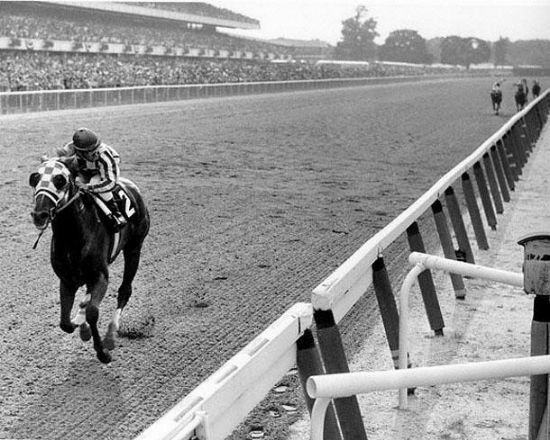Secretariat, or “Big Red” as he was affectionately known, was raring to go on the morning of June 9, 1973. Only five horses were competing for the Belmont Stakes that day, and even though Secretariat had proved himself a champion, another horse named Sham was favored to win. But no one told Secretariat. He and Sham busted out of the gate in a head-to-head race for the lead. They ran the half-mile in 46.5 seconds, a “suicide pace” for the mile-and-a-half race. Indeed, it proved too much for Sham who was injured, finished last, and never competed again. This left Secretariat, who competed only against himself. He finished the last quarter in an astonishing 25 seconds and won the Belmont Stakes 31 lengths ahead of the other horses, setting a world record that has yet to be broken. This amazing Triple Crown winner went on to earn more than $1 million for his owner and was syndicated for stud at more than $6 million.

Secretariat at the Belmont Stakes, 1973
What many people don’t realize is that Secretariat’s owner was an officer in the U.S. Army Corps of Engineers during World War I. Christopher T. Chenery was born in Richmond, Virginia, in September 1886. He was raised in Ashland, Virginia, where he attended Randolph Macon College for two years and went on to graduate from Washington and Lee University with a bachelor’s degree in engineering in 1909. While attending school he worked in engineering for the Virginia Railway Company and helped plot the railway’s Appalachian route through Virginia and West Virginia. He also briefly taught engineering at Washington and Lee University.
 |
|
|
Secretariat, "in another ZIP code," in the homestretch.
|
|
Following graduation he was an engineer in Oregon, Washington, and Alaska. In 1914 he worked as a member of a reconnaissance party in Alaska that surveyed 600 square miles and explored possible railroad routes from Cooks Inlet to the Yukon. Later engineering positions took him to Chicago, Illinois, which is where he joined the Corps of Engineers in 1917 during World War I. He commanded companies at the Engineers' training camp at Camp Humphreys (now Fort Belvoir), Virginia. Serving the Corps for three years, he reached the grade of major.
Chenery went on to become a successful businessman in the water, gas, and pipeline industry. In addition to his distinguished career, he also was interested in the breeding and racing of thoroughbred horses. Named by Chenery’s daughter, Penny, and his executive secretary Elizabeth Ham, Secretariat was featured on the covers of Time, Newsweek, and Sports Illustrated magazines in the same week, named one of the top athletes of the 20th century by ESPN, and is considered among the greatest thoroughbred racehorses ever.
* * *
May 2004